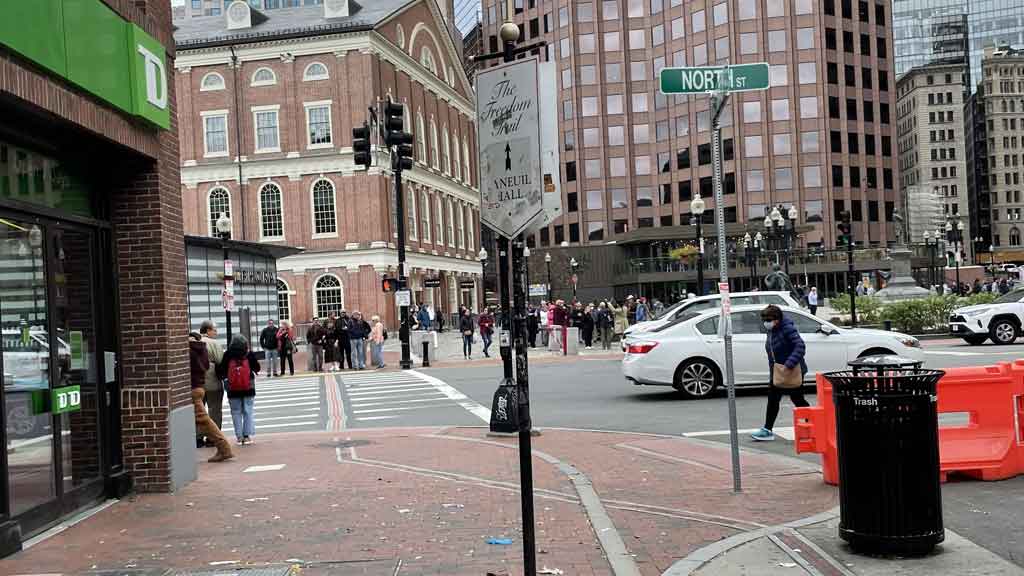In the vivid tapestry of Boston’s historic landscape, the starting point of the Freedom Trail beckons eager explorers to embark on a journey through time.
Located within the verdant expanse of Boston Common, the Massachusetts State House stands as a sentinel of democracy and a symbol of America’s enduring quest for freedom.
Its majestic facade, crowned by a glistening golden dome, serves as the gateway to a trail laden with the echoes of revolution and the spirit of independence.
As visitors step foot upon the crimson path, they are transported back to the crucible of American history, where the ideals of liberty and democracy were forged amidst the tumult of revolution.
Where Is the Freedom Trail Boston Starting Point?
The address of the Freedom Trail Boston Starting Point is:
Massachusetts State House, 24 Beacon St, Boston, MA 02133, United States.
Where to Start the Freedom Trail in Boston?
Begin your journey through Boston’s rich history at the Massachusetts State House, located at the corner of Tremont and Park Streets within the iconic Boston Common.
This historic landmark, with its distinctive golden dome, serves as the official starting point of the Freedom Trail.
From here, follow the red brick path for a 2.5-mile adventure through 16 significant sites, including the Granary Burying Ground and the Old State House, immersing yourself in the story of America’s quest for freedom.
What Is the First Stop on the Freedom Trail?

The initial stop on Boston’s renowned Freedom Trail is the Massachusetts State House. This architectural gem, crowned with a gleaming golden dome, stands proudly within the historic Boston Common.
Built in 1798, it has been the epicenter of Massachusetts governance for over two centuries. Visitors can explore its neoclassical halls and chambers, steeped in political history, before embarking on their journey through time along the trail’s crimson path.
As the inaugural site, the State House sets the stage for an immersive exploration of America’s revolutionary past.
Where Does the Freedom Trail in Boston End?
The Freedom Trail culminates its historic journey at the Bunker Hill Monument in Charlestown, marking the site of the Battle of Bunker Hill, a pivotal conflict in the American Revolutionary War.
This towering granite obelisk stands 221 feet tall, commemorating the bravery and sacrifice of patriots who fought for independence.
Visitors can climb the 294 steps to the top for panoramic views of Boston and its surrounding harbor, reflecting on the enduring legacy of liberty and democracy that reverberates throughout the nation’s history, concluding their immersive experience on Boston’s iconic trail.
Can You Walk the Boston Freedom Trail on Your Own?

Yes, absolutely! The Boston Freedom Trail is designed to be self-guided, allowing visitors to explore at their own pace and according to their interests.
The trail is well-marked with a distinctive red brick path or painted line along sidewalks and streets, making it easy to follow from start to finish.
Along the route, you’ll encounter numerous historical sites, markers, and informative plaques that provide context and insight into each location’s significance in American history.
Whether you prefer to stroll leisurely, take photographs, or delve deeply into the details of each stop, walking the Freedom Trail independently offers a flexible and enriching experience for history enthusiasts and curious travelers alike.
What Is the Best Way to Experience the Freedom Trail in Boston?
The best way to experience the Freedom Trail in Boston is to embark on a self-guided walking tour, allowing you to explore at your own pace while immersing yourself fully in the rich history of the city.
Here’s how to make the most of your experience:
Start Early

Begin your journey early in the day to avoid crowds and make the most of your time at each site. Early mornings often offer quieter streets and cooler temperatures, allowing for a more leisurely and enjoyable exploration of the trail.
Grab a Map or Guidebook
Pick up a map or guidebook at the visitor center or download one online to help navigate the trail and learn about each stop along the way.
These resources provide valuable information about the historical significance of each site, enhancing your understanding and appreciation of Boston’s rich history.
Wear Comfortable Shoes

The trail covers approximately 2.5 miles of walking, so be sure to wear comfortable shoes to keep your feet happy throughout the journey.
Sneakers or walking shoes with good support are ideal for traversing the cobblestone streets and uneven terrain of some historic sites.
Take Your Time
Don’t rush through the trail. Take the time to appreciate each site, read the informative plaques, and soak in the historical significance of each location. Pause to admire the architecture, explore hidden corners, and imagine the events that unfolded at each stop.
Engage with History
Imagine yourself stepping back in time as you visit each stop on the trail. Visualize the events that unfolded at each site and consider the impact they had on shaping American history.
Engage your senses by listening for echoes of the past and envisioning life in colonial Boston.
Visit Interior Sites
While many sites on the Freedom Trail are exterior landmarks, some, like the Paul Revere House and Old North Church, offer interior tours for a more immersive experience.
Take advantage of these opportunities to step inside historic buildings, where you can learn about daily life in colonial times and interact with knowledgeable guides.
Bring Water and Snacks

Stay hydrated and energized by bringing along a water bottle and some snacks to enjoy along the way.
Boston’s diverse neighborhoods offer plenty of opportunities to pick up refreshments, but having provisions on hand ensures you can stay fueled during your exploration of the trail.
Consider a Guided Tour
If you prefer a more in-depth experience, consider joining a guided tour led by a knowledgeable historian or local guide who can provide additional context and insight into the history of Boston and the American Revolution.
Guided tours offer a structured itinerary and the expertise of a knowledgeable leader, allowing you to gain a deeper understanding of the trail’s significance.
End with a View
Conclude your journey at the Bunker Hill Monument in Charlestown, where you can climb to the top for panoramic views of Boston and reflect on the historical significance of your Freedom Trail adventure.
From this vantage point, you can see the city skyline, the harbor, and iconic landmarks, providing a fitting end to your exploration of Boston’s rich history.
FAQs
Where does the Freedom Trail in Boston begin?
The Freedom Trail starts at the Massachusetts State House, located within Boston Common, the oldest public park in the United States.
What can I expect to see at the starting point of the Freedom Trail?
At the starting point, you’ll encounter the iconic Massachusetts State House, characterized by its distinctive golden dome and neoclassical architecture.
Is there a visitor center or information available at the starting point?
Yes, visitors can find information about the Freedom Trail and its historical significance at various locations near the starting point, including the Boston Common Visitor Information Center.
How long does it take to explore the starting point of the Freedom Trail?
Exploring the starting point, including the Massachusetts State House, can take anywhere from 30 minutes to an hour, depending on your level of interest and whether you choose to take a guided tour.
Can I visit the starting point of the Freedom Trail at any time of day?
Yes, Boston Common and the Massachusetts State House are open to the public during daylight hours, allowing visitors to explore the starting point of the Freedom Trail at their convenience.
Wrap Up
At the threshold of Boston’s illustrious Freedom Trail, the Massachusetts State House stands as a testament to the enduring legacy of liberty.
Its golden dome, gleaming against the backdrop of Boston Common, represents not just a landmark but a beacon of democracy.
Through the trail’s winding path, visitors traverse centuries of history, from the birth pangs of revolution to the triumphs of independence.
Each step echoes with the footsteps of patriots, reminding us of the sacrifices made in the pursuit of freedom.
As the starting point of this transformative journey, the State House ignites a spark of curiosity and reverence, inviting all who tread its path to discover the vivid tapestry of America’s past and the ideals that continue to shape its future.
Naim Benmayor